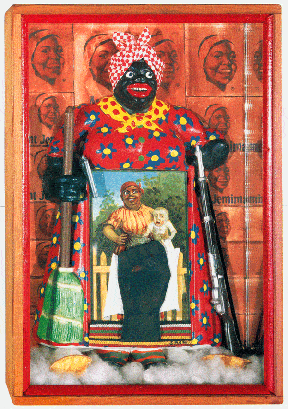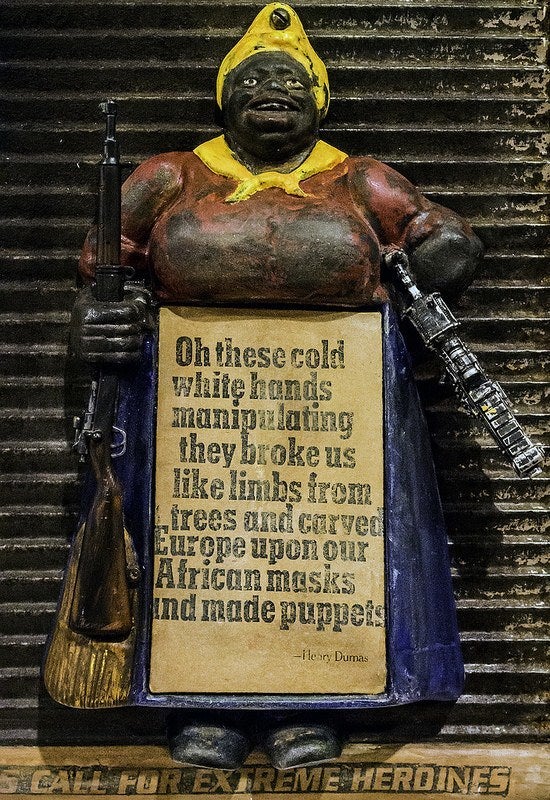Artist Betye Saar is known for creating small altars that commemorate and question issues of both time and remembrance, race and gender, and personal and public spaces. College art history surveys often cover Saar’s 1972 assemblage box The Liberation of Aunt Jemima as a pivotal point of momentum in the contemporary feminist art scene and/or African-American art scene of the ‘60s and ‘70s. But Saar has always been hesitant to accept such categorical designations. Through her art, Saar has had a lasting influence upon the art world today.

With The Liberation of Aunt Jemima, Saar took a well known stereotype and caricature of Aunt Jemima, the breakfast food brand’s logo, and armed her with a gun in one hand and a broom in the other. Saar lined the base of the box with cotton. The surrounding walls feature tiled images of Aunt Jemima sourced from product boxes. She places a figurine of Jemima in the center as a Black Panther leader, modeled after Huey Newton’s iconic portrait. In Saar’s words, “I take the figure that classified all black women and make her into one of the leaders of the revolution–although she is a pretty strong character anyway.” Her work can be defined by its biting humor and forceful, subversive messages.
In an article for Feminist Studies, Josephine Withers provides a comprehensive history of Saar’s earlier boxes and their transformation from public discourse to one of personal reflection and exploration. Withers integrates Saar’s words and goals throughout, exploring and explaining the artist’s motivations to reappropriate and redefine Aunt Jemima. Also included is an examination of her later work, which deals with more personal topics like her divorce that used as its medium personal family heirlooms.
As Saar says:
The idea of the work, the accumulation of the materials, the putting them together, the sharing of a work are all part of a ritual. This process of objectification is…purification. Once in the world, the artwork can become part of someone else’s ritual.
The artist was influenced by Joseph Cornell’s assemblage boxes after seeing them at the Pasadena Art Museum in 1967. “While the look and the references in Cornell’s work are entirely different, his small and magical boxes opened Saar’s imagination to the possibilities of making art out of all the bits and pieces, the visual oddments that Saar had been collecting since childhood,” Withers observes.

In “Reclaiming Histories: Betye and Alison Saar, Feminism, and the Representation of Black Womanhood,” Jessica Dallow delves deeply into the work and legacies of both Betye Saar and her daughter Alison Saar (also an artist in her own right). Dallow’s introduction complicates both Betye and Alison’s concepts of being feminists without wanting to be pigeonholed under the category of “feminist art”—much in the same way that Saar’s work doesn’t need be categorized as “powerful African American art” when it’s simply powerful art.
“In downplaying the feminist content of her art,” Dallow continues, “Betye Saar has instead emphasized its cross-culturalism, autobiography, and spirituality.” Through Dallow’s exploration of the mother-daughter duo, she looks at both the scope and effect of their work and its continued influence. “The Saars’ intergenerational explorations of race, history, and the black female body represent a crucial step to reclaim the contentious history surrounding the visual representation of African American women.” Through reclamation and subversion, Alison and Betye Saar challenge viewers to consider complex and intricate themes through a distinctly personal lens.







